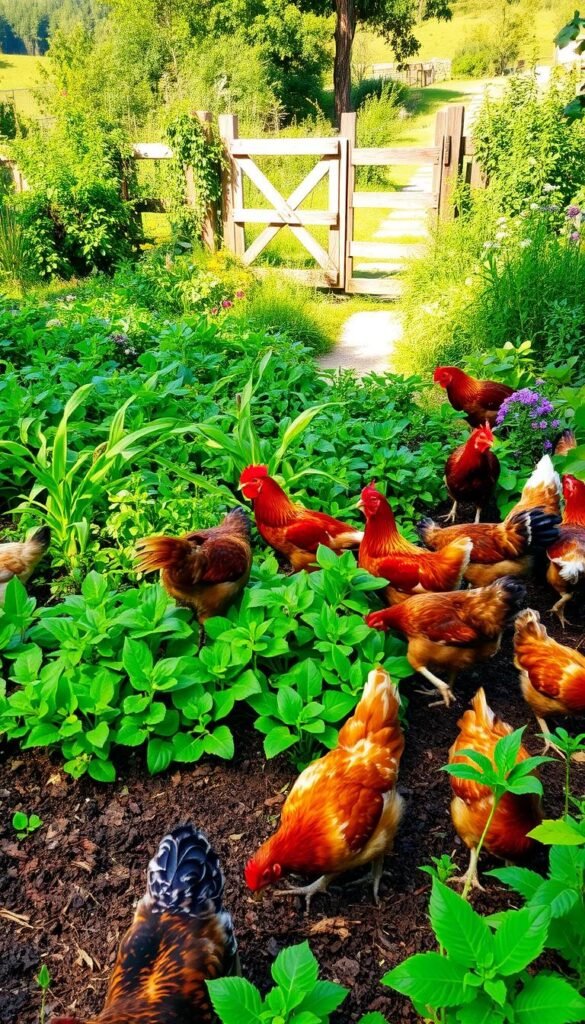Imagine turning your backyard into a lively, balanced ecosystem where every element supports the next. This isn’t just gardening—it’s a smarter way to work with nature rather than against it. By blending time-tested practices with innovative ideas, you can create a space that thrives year-round with minimal effort.
One surprising ally in this journey? Feathered helpers that do more than just provide eggs. When paired with thoughtful land management, these birds become multitasking partners. They scratch pests away, enrich soil naturally, and even recycle kitchen scraps into valuable resources.
This approach isn’t just about growing food—it’s about building relationships. Plants and poultry support each other in ways that boost productivity while cutting waste. For example, permaculture gardens thrive when animals and crops coexist, creating cycles that mimic nature’s own patterns.
You’ll soon see how small changes can lead to big results. Healthier soil, fewer pests, and happier plants are just the start. Best of all? This system rewards you with fresh produce and the joy of watching your outdoor space come alive.
Understanding Self-Sustaining Garden Methods
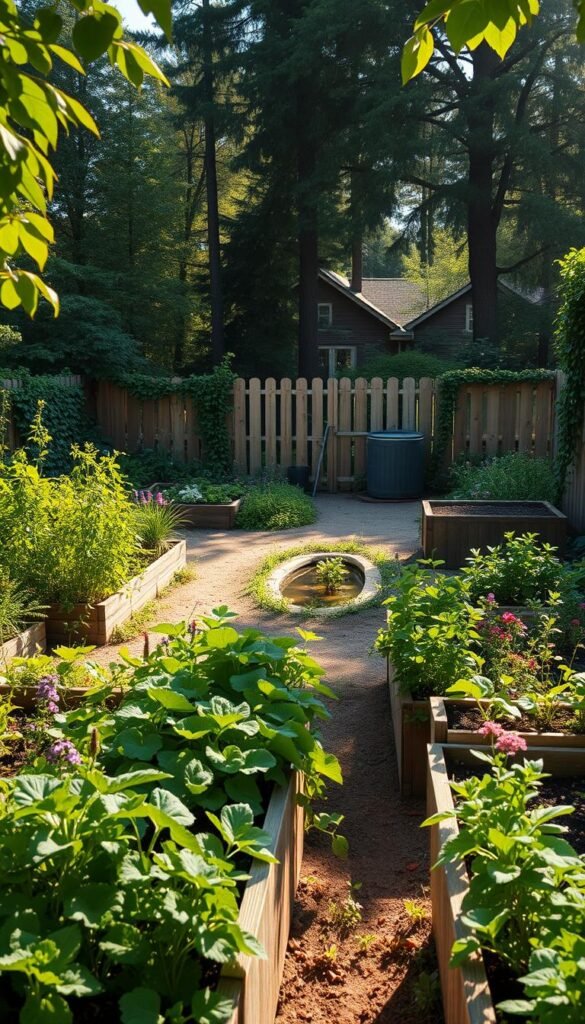
Discover how interconnected systems can make your outdoor space thrive with less effort. Unlike traditional plots that need constant care, these systems turn challenges into opportunities. Think of it as nature’s teamwork—where every plant, animal, and microbe plays a role.
At its core, this approach mimics wild ecosystems. Instead of fighting weeds or pests, you’ll design spaces where chickens till soil naturally while eating bugs. Their manure becomes free fertilizer, closing nutrient loops without chemicals. This reduces waste and builds richer soil over time.
Here’s how it compares to conventional methods:
| Aspect | Traditional Gardening | Self-Sustaining Approach |
|---|---|---|
| Pest Control | Chemical sprays | Chickens & companion plants |
| Soil Health | Store-bought fertilizers | Compost & animal manure |
| Land Use | Single-purpose zones | Multi-functional spaces |
Urban gardeners love this philosophy because it maximizes small areas. A single environment can grow food, house chickens, and recycle scraps. You’ll spend less money and create habitats that support biodiversity.
Ready to rethink your land? Start by observing how sunlight, water, and wildlife interact in your space. Small tweaks—like adding a mobile coop—can spark big changes in productivity and sustainability.
Benefits of Integrating Chickens into Your Garden
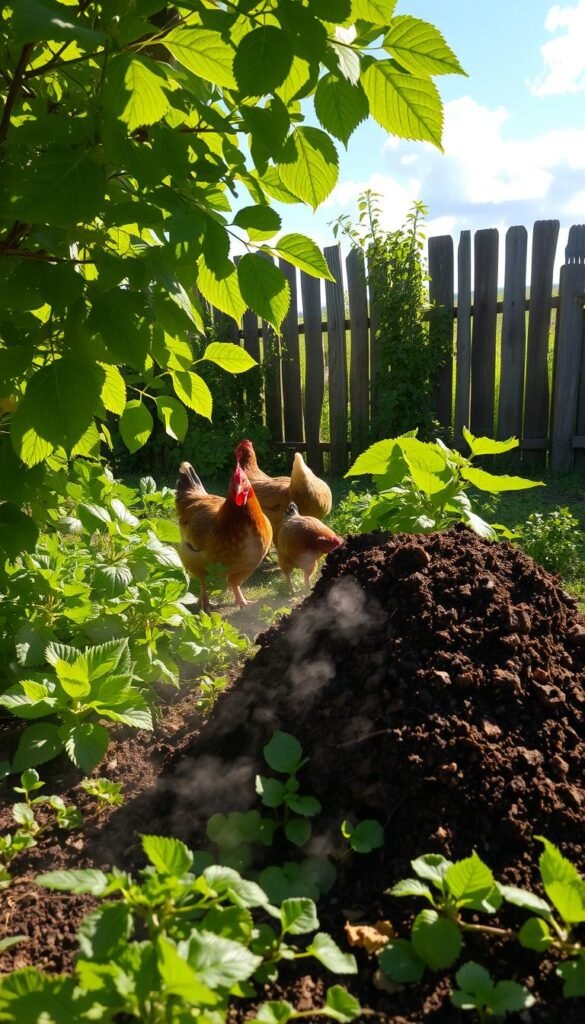
What if your feathered friends could do more than lay eggs? These lively birds offer hidden perks that transform your outdoor space into a dynamic partnership. Their daily habits create ripple effects that nourish plants, deter pests, and cut down on household waste.
Nutrient-Rich Manure for Soil Fertility
Chicken droppings pack a punch. They contain three times more nitrogen than cow manure, along with phosphorus and potassium. Let it compost for 4-6 months, and you’ll get black gold that feeds plants while improving soil structure.
Unlike synthetic fertilizers, this organic option releases nutrients slowly. Your tomatoes and greens get steady meals without chemical burns. Plus, it boosts microbial activity underground—nature’s way of building long-term fertility.
Natural Pest Control and Waste Reduction
Watch chickens hunt. Their scratching uncovers grubs and beetles, while their pecking devours slugs and weed seeds. A single bird can eat up to 100 insects daily—free pest management with no sprays.
They’re also master recyclers. Toss carrot tops or wilted lettuce into their run. Leftovers become eggs and richer manure instead of trash. Over time, this cycle slashes grocery bills and landfill trips.
Key Principles of Permaculture Garden Design
Designing a thriving space where plants and poultry work together starts with smart layout choices. Picture zones that balance freedom with structure—chickens get room to explore, while tender greens stay safe. This dance between wild energy and careful planning keeps your system productive.
Strategic Barriers for Plant Safety
Raised beds with 18-inch walls keep curious beaks away from seedlings. Use hardware cloth under soil to block digging. For open areas, temporary electric netting creates movable boundaries that adapt as plants grow.
Rotational Grazing Made Simple
Move chickens through different sections weekly. They’ll devour weeds and pests without stripping the land bare. Here’s how it compares to continuous grazing:
| Approach | Grazing Duration | Vegetation Recovery | Soil Impact |
|---|---|---|---|
| Continuous | Unlimited | Poor | Compaction |
| Rotational | 3-7 days | Full regrowth | Aerated |
Always include shaded spots and water stations in each zone. In summer, add frozen herb treats to keep chickens cool while they work. This management style turns them into seasonal partners—fertilizing in fall, pest patrol in spring.
Choosing the Right Chicken Coop and Run Setup
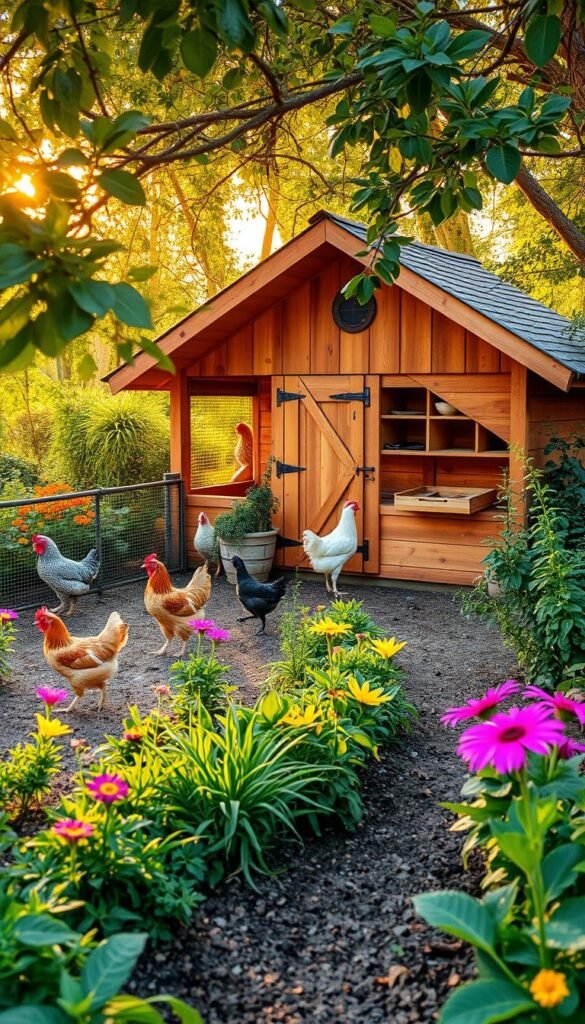
Your flock’s home base shapes their health and your convenience. Whether you’re housing three hens or twelve, the right structure balances protection with practicality. Let’s explore how different designs serve various needs.
Stationary Structures for Established Flocks
Traditional barn-style coops offer permanent shelter with nesting boxes and roosting bars. These work best for urban yards with 4-8 chickens. Each bird needs 2-3 sq ft inside—a 6×4 ft coop comfortably houses eight.
Mobile Options for Rotational Grazing
Portable “tractors” let birds forage fresh grass daily. Lightweight frames on wheels move easily across your space. They’re ideal for larger properties where chickens can fertilize different zones weekly.
| Feature | Traditional Coop | Portable Tractor |
|---|---|---|
| Space Efficiency | Fixed footprint | Adapts to yard layout |
| Materials | Wood (durable) | Metal/plastic (light) |
| Maintenance | Monthly cleaning | Weekly relocation |
Wood coops last longer but need weatherproofing. Metal stays cleaner but overheats in summer.
“Adequate space prevents stress and disease,”
notes a poultry keeper from Ohio. For growing flocks, modular designs let you add sections as needed.
Convert sheds or playhouses into coops to save costs. Just ensure 8-10 sq ft of outdoor space per bird. Your choice impacts daily chores and long-term flock happiness—choose wisely.
Setting Up Your Garden Space for Chicken Integration
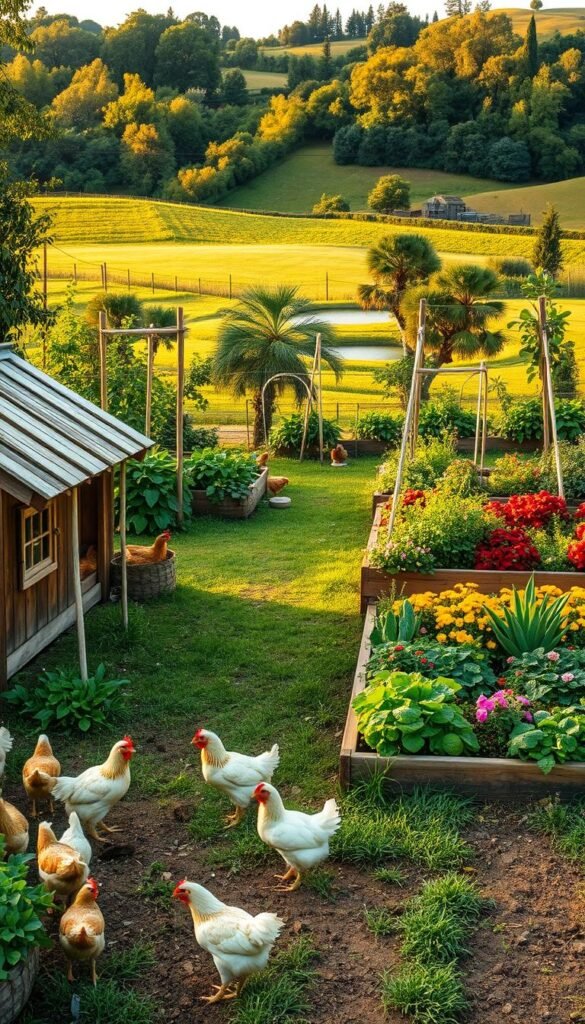
Create a harmonious space where chickens and crops thrive side by side through strategic planning. Start by mapping out zones that balance foraging freedom with plant protection. Think of it as designing neighborhoods—each area serves a purpose while keeping the whole system connected.
Creating Safe Zones with Smart Barriers
Protect seedlings without blocking pest patrols. Install 12-inch wire mesh around raised beds—tall enough to deter scratching but low enough for chickens to spot bugs. For delicate crops like lettuce, add lightweight row covers that lift easily during supervised grazing time.
Three barrier materials that blend function and aesthetics:
- Woven willow fences (bendable and natural-looking)
- Repurposed pallet wood with 2-inch gaps
- Decorative stones along bed edges
Guiding Movement with Pathways
Design 3-foot-wide walkways between growing areas using materials chickens avoid walking on. Crushed gravel or wood chips work best—they’re comfortable for your feet but uncomfortable for clawed visitors. These paths become natural boundaries, steering flocks toward weeds instead of your tomatoes.
| Zone Type | Ideal Plants | Chicken Access |
|---|---|---|
| Open Foraging | Mature fruit trees | Unrestricted |
| Protected Beds | Leafy greens | Supervised only |
| Buffer Corridor | Herbs & flowers | Seasonal |
Rotate water stations every 15 feet in hot months. A Maryland gardener shares:
“Hanging buckets under shade trees keeps water cool and gives birds reason to visit neglected corners.”
In winter, use temporary fencing to shrink the run near shelters. Come spring, expand zones gradually as plants establish—your feathered crew gets new hunting grounds just as pests emerge.
Mastering the Deep Litter Method for Chicken Coops
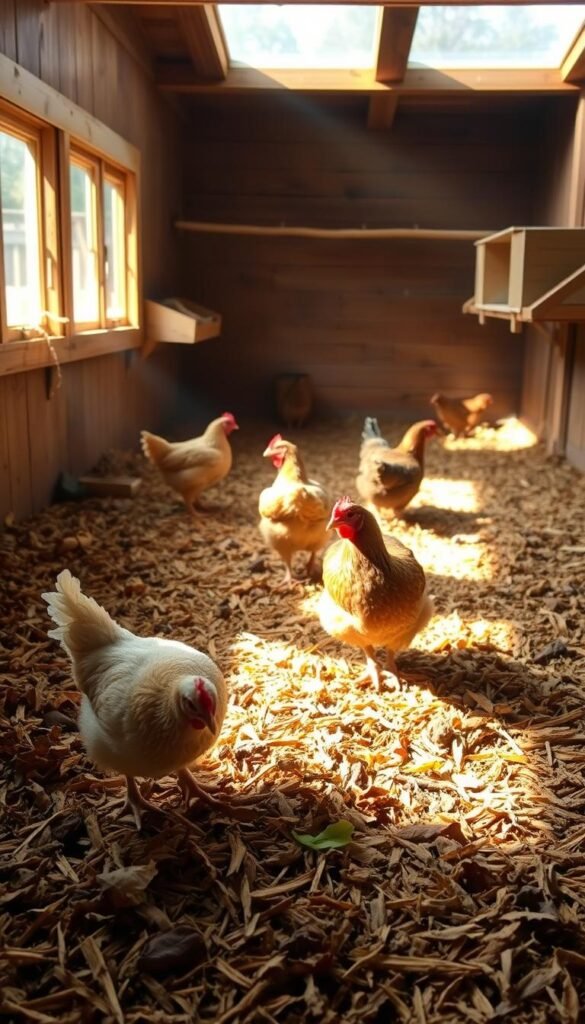
What if your coop could clean itself while producing rich compost? This innovative approach turns floor maintenance into a hands-off process. By harnessing natural decomposition, you’ll create healthier living conditions for your flock and nutrient-dense fertilizer for plants.
Steps to Implementing Deep Litter Bedding
Begin with a 4-inch base of bedding—kiln-dried pine shavings work best. Add 2 inches every week until reaching 12 inches. The material should feel loose and fluffy, allowing airflow to prevent moisture buildup.
Stir the layers weekly with a rake. This mixes manure evenly and speeds decomposition. In 3-4 months, you’ll notice a crumbly texture and earthy smell—signs your compost is ready for the garden.
Selecting Ideal Materials for Deep Litter
Choose materials that balance absorbency and structure. Here’s how common options compare:
| Material | Absorbency | Decomposition Time |
|---|---|---|
| Wood Shavings | High | 4-6 months |
| Shredded Leaves | Medium | 2-3 months |
| Straw | Low | 6-8 months |
Avoid cedar chips—their oils irritate respiratory systems. If ammonia smells develop, add more carbon-rich bedding immediately. One Ohio farmer notes:
“When I switched to deep litter, my chickens stopped getting mites. The system works better than weekly cleanouts!”
Monitor moisture levels after rainy days. Properly maintained, this method eliminates daily scooping while giving birds endless scratching opportunities. Your coop stays fresher longer, and your garden gains black gold.
Self-Sustaining Garden Methods: Introducing Chickens and Natural Fertilizers
Your flock’s droppings hold surprising potential. Packed with nitrogen, phosphorus, and potassium, chicken manure offers three times more nutrients than cow waste. But fresh deposits can harm plants—their high ammonia content burns roots and may carry harmful bacteria.
Composting transforms raw waste into plant-safe gold. Layer manure with straw or leaves in a 1:2 ratio. Turn the pile weekly to oxygenate microbes that break down pathogens. In 4-6 months, you’ll get crumbly fertilizer that feeds plants slowly without chemical spikes.
| Aspect | Fresh Manure | Composted |
|---|---|---|
| Nitrogen Content | 1.5% (Volatile) | 0.5% (Stable) |
| Pathogen Risk | High | None |
| Application Timing | Not Recommended | Pre-planting |
Pair this process with organic gardening basics for maximum impact. Spread finished compost 3 weeks before seeding to let nutrients integrate with soil. A Wisconsin grower shares:
“Since switching to composted manure, my bean yields doubled. The plants stay greener longer during droughts.”
Rotate chickens through different garden zones seasonally. They’ll fertilize resting beds while pecking weed seeds. This closed-loop approach cuts store-bought inputs and turns waste into growth fuel—nature’s efficient way to build fertility.
Enhancing Soil Fertility with Natural Fertilizers
Want richer earth that grows healthier plants? The secret lies beneath your flock’s feet. Composted manure acts like a multivitamin for your soil, feeding plants while creating spongy texture that holds moisture and nutrients.
When properly broken down, this organic material becomes a powerhouse. It hosts beneficial microbes that unlock minerals trapped in clay or sand. These tiny workers boost root development and help plants resist droughts.
Here’s why composting matters:
| Factor | Fresh Manure | Composted |
|---|---|---|
| Nitrogen Availability | Too Harsh | Slow Release |
| Weed Seeds | Present | Destroyed |
| Application Safety | Wait 120 Days | Use Immediately |
Time your applications with the seasons. Spread finished compost 3 weeks before planting spring crops. For fall beds, mix it into the topsoil after harvest. A California grower shares:
“My pepper production jumped 40% once I started testing soil pH yearly. Now I adjust compost amounts based on each bed’s needs.”
Simple tests reveal what your land craves. Kits from garden stores measure nitrogen, phosphorus, and potassium levels. Match results to crop requirements—leafy greens thrive with extra nitrogen, while tomatoes want more phosphorus.
This approach builds self-renewing systems. Your birds contribute manure, which becomes food for plants that later feed your family. It’s nature’s blueprint for abundance, minus the chemical dependency.
Creative Approaches to Managing Garden Waste
What if your kitchen scraps could power your garden’s growth? Your flock holds the key to turning everyday leftovers into nutrient-rich resources. By reimagining how you handle organic material, you’ll slash trash output while keeping birds healthy and engaged.
Chickens act as living composters, devouring up to 1.5 pounds of scraps daily. They transform apple cores, wilted greens, and squash rinds into fertilizer through digestion. This process cuts landfill trips and enriches eggs with diverse nutrients.
Composting Kitchen Scraps Effectively
Not all leftovers belong in the run. Stick to safe options like cooked grains, vegetable peels, and melon rinds. Avoid avocado pits, raw potatoes, and citrus—these can harm digestion or attract pests.
| Best Scraps | Avoid These |
|---|---|
| Leafy greens | Onion skins |
| Berry hulls | Chocolate |
| Pumpkin seeds | Moldy bread |
For non-edible waste like corn stalks, build a compost system beside the coop. Layer yard trimmings with manure, turning monthly. By spring, you’ll have black gold ready for planting.
“Our compost pile became a bug buffet for the hens—they scratch through it daily,”
Adjust strategies seasonally. In summer, freeze excess scraps into ice blocks for cooling treats. Winter calls for heated water bowls to prevent frozen leftovers. With smart sorting, you’ll turn waste into wealth year-round.
Addressing Common Challenges in Permaculture with Chickens
Keeping chickens in your permaculture setup brings rewards, but it’s not without its hurdles. Predators like raccoons or hawks might eye your flock. Motion-activated lights and buried wire fencing around coops deter most nighttime visitors while letting birds roam safely by day.
Health issues can pop up if you’re not vigilant. Rotate grazing areas to prevent parasite buildup, and add garlic to their water for natural worm control. A dust bath spot with wood ash keeps feathers clean and mites at bay.
Some people worry about birds damaging tender plants. Train chickens early by limiting access to young crops. Use temporary fencing until greens mature—they’ll focus on weeds instead of your kale.
Timing matters. Let birds into beds after harvest to scratch up pests and fertilize soil. In spring, keep them away until seedlings establish. With smart planning, your feathered crew becomes partners in solving garden things rather than causing new ones.

